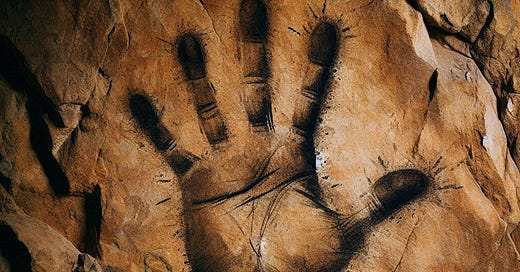Humanity began when someone talked to the hand
Tropes distinguish us from other species. Which isn’t always a good thing.
It almost certainly went like this:
Our ancestors in the way-back times spent many happy hours decorating themselves. They stuck leaves in their hair, often on purpose. Finding seashells with holes in them, they threaded palm-leaf strips through the holes. Eventually someone got the brilliant idea to twist the threaded strands together to make a necklace. After many lost necklaces, some brilliant ancestor invented the knot. Soon anybody who was anybody was wearing a necklace. The showier ones wore many necklaces.
Meanwhile, our less classy forebears were wiping their faces with hands that got sooty from the fire. At first this seemed hilarious. You could hardly recognize your own relative when he got soot-faced. Plus, when you soot-faced yourself, you could sneak up on people in the dark and scare them. Inevitably, soot-facing became a very good military tactic, an early form of camouflage, and sort of magical. By blackening yourself like the night, benighting yourself, you became the night.
At some point, somebody who had been picking red berries wiped her sweaty face red. Vigorous experimentation soon followed, and warriors began painting their faces magnificent colors to terrify their plain-faced enemies. The painted warriors demonized themselves, becoming virtual demons.
After many generations of creative, enjoyable, sometimes violent face-painting, a teenager realized that when you chewed up a mouthful of berries and blew them through a hollow reed, you could blast your siblings. He (it was almost certainly a he) thus invented both spray-painting and the sport of paintball.
Others began experimenting with various reeds to find the ideal paint sprayers. They tested each reed by placing a hand on a flat rock and blasting chewed berries over the whole hand. After one especially successful hand blasting, the experimenter pulled away from the rock and…whoa! The outline of the hand appeared on the rock like magic! (Much later, artists would come to call this phenomenon “negative space” and use the invention to generate grant money.)
Rock hand outlines became all the rage, to the point where every stone in sight, along with the entrance to every cave, was covered in hand graffiti. Respectable people complained, so the elders banned hand spraying.
Naturally, the rebel hand sprayers moved to the deepest, creepiest parts of caves. They took turns holding a fatwood torch while the others sprayed away. They formed a club and practiced cool rituals, and let only a few into the secret.
One day, a founder of the club, an especially popular guy, managed to get himself eaten by a bear. There was hardly anything left of him, just a few bones; and unlike the sensitive, artistic and rather fey Neanderthals in the next valley, this group hadn’t thought of burying their dead. What was the point?
Still, his mates missed him. They gathered in their deep cave club quarters, too sad to do any hand spraying. Then one of them walked over to a print on the cave wall. It had been made by their dead friend. “This is him.”
The subjective case had not yet been invented, which is why he didn’t say “This is he.”
Nor did he say, “This is his hand,” or “This is his art,” or “Man, that guy had tiny fingers.” He said, “This is him.” This almost certainly counts as the first expression of a trope: the outline of a hand representing the dead owner of that hand.
Our ability to play pretend with things—turning parts of something into the thing itself; changing similar things into identical things, disguises into transformations, animals into people—these mutations soon helped us manipulate the world around us. Our trope-forward thinking eventually led to myriad inventions and organizations.
Tropes are the most human of all the traits. More than other attribute, the trope distinguishes us from other species. Which isn’t always a good thing. But I love tropes. They make our world go round. (See what I did there?) All of rhetoric, and our constant manipulation of each other, begin and end with tropes. These soul-bending devices start wars, and they end them.
Future posts will play with tropes in all their twisted glory: metaphor, metonymy, synecdoche, irony, personification, plus the most mind-blowing one, the GOAT of all tropes, hyperbole. But in the beginning, tropes were just a human instinct, a matter of playing pretend and then sort of believing in the pretense. If you want to be cynical about it, you could say that our deepest humanity comes from our uncanny ability to lie to ourselves.
In the years after the bear ate the friend, more club members died, and the survivors began nostalgically wandering to the back of the cave and holding one-way conversations with the deceased, talking to the hands. None of the Neanderthals had thought of doing this. Other species had been ornamenting themselves for millions of years. But only one subspecies, Homo sapiens—specifically a raffish, unpopular subset of a tribe within this subspecies—played pretend with the sprayed body part of a missing friend.
Homo sapiens had existed for hundreds of thousands of years. But only at this moment, “This is him,” did humanity begin. No other species could invent a trope like this. Eventually, this ability would help to create art, imagine the future, build civilizations, invent computers…
And, eventually, almost certainly, the same trope-making aptitude that had spelled humanity’s beginning, would bring about its end.





Loved this